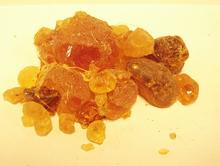Al-Mu'izz ibn Badis
Al- Muʻizz ibn Bādīs (Arabic: المعز بن باديس); 1008–1062) was the fourth ruler of the Zirids in Ifriqiya, reigning from 1016 to 1062.
Political career
Al-Muizz ascended the throne as a minor following the death of his father Badis ibn Mansur, with his aunt acting as regent. In 1016 there was a bloody revolt in Ifriqiya in which the Fatimid residence Al-Mansuriya was completely destroyed and 20,000 Shiites were massacred. The unrest forced a ceasefire in the conflict with the Hammadids of Algeria, and their independence was finally recognized in 1018.
Al-Muizz took over the government in 1022 following the overthrow of his aunt. The relationship with the Fatimids was strained, when in 1027 they supported a revolt of the Zanatas in Tripolitania which resulted in permanent loss of control of the region. His son Abdallah shortly ruled Sicily in 1038-1040, after intervening with a Zirid army in the civil war that broke out in the island.
The political turmoil notwithstanding, the general economic wellbeing initially made possible an extensive building programme. However, the kingdom found itself in economic crisis in the 1040s, reflected in currency devaluation, epidemic and famine. This may have been related to the high level of tribute which the Zirids were compelled to pay annually to the Fatimids (one million gold dinars a year).
When al-Muizz (under the influence of Sunni jurists in Kairouan, growing Sunni public pressure in his realm and a violent backlash against the Shi'ite minority) recognised the Abbasids in Baghdad as rightful Caliphs in 1045 and adopted Sunni orthodoxy,[1][2] the break with the Fatimids was complete.[3] He even denounced the Fatimids and their followers as heretics in newly minted coinage.[4]
The Fatimids then deported the Bedouin tribes of the Banu Hilal and the Banu Sulaym from Egypt to Ifriqiya. The invasion of the Bedouin (1051–1052) led to great hardship after the defeat at Jabal Haydaran, severely impacting agriculture in Ifriqiya. The conquest of Kairouan in 1057 resulted in further anarchy. The Zirids lost control over the hinterland and were only able to retain the coastal areas, the capital being moved to Mahdia. With the growth of Bedouin Emirates and the continuing insecurity inland, the economy of Ifriqiya looked increasingly towards the Mediterranean, with the result the coastal cities grew in importance through maritime trade and piracy.
Al-Muizz was succeeded by his son Tamim ibn Muizz.
Attributed works

He is usually thought to be[5] the author of the famous Kitab `umdat al-kuttab wa `uddat dhawi al-albab (Staff of the Scribes). It is divided in twelve chapters, writes amongst others on the excellence of the pen, he wrote on the preparation of types of inks, the preparation of colored inks, metallic inks (including ones prepared from silver filings and alcohol), the coloring of dyes and mixtures, secret writing, the making of paper and the Arabic gum and glue.[6][7]
References
- ↑ Ivan Hrbek (1 Jan 1992). Africa from the Seventh to the Eleventh Century (abridged, illustrated ed.). James Currey Publishers. pp. 172–3. ISBN 9780852550939.
- ↑ Linda G. Jones (6 Aug 2012). The Power of Oratory in the Medieval Muslim World. Cambridge University Press. p. 136. ISBN 9781107023055.
- ↑ Trudy Ring; Noelle Watson; Paul Schellinger (5 Mar 2014). Middle East and Africa: International Dictionary of Historic Places. Routledge. p. 37. ISBN 9781134259939.
- ↑ Luscombe, David; Riley-Smith, Jonathan, eds. (2004). The New Cambridge Medieval History, Volume 2; Volume 4. Cambridge University Press. p. 696. ISBN 9780521414111.
- ↑ Levey, Martin (1962). "Mediaeval Arabic Bookmaking and Its Relation to Early Chemistry and Pharmacology". Transactions of the American Philosophical Society. New Series 52 (4): 1–79. ISSN 0065-9746. JSTOR 1005932.
- ↑ http://www.muslimheritage.com/topics/default.cfm?ArticleID=224
- ↑ http://www.history-science-technology.com/Articles/articles%2072.htm
| ||||||||||||||||||||||||||||||||||||||||||||
|